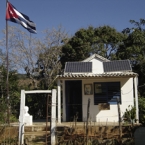Cuba’s Energy Revolution: Yes They Can!
Barack Obama has proposed to invest $150 billion in renewable energy and energy efficiency over the next ten years. He need look no further than La Havana for inspiration. Cuba has successfully greened its energy sector over the last few years, and is now exporting its energy revolution. Will we soon benefit from Cuban expertise in cleaning up the US energy sector?
Just a few years ago, Cuba was plagued by frequent power blackouts – the result of inefficient generation in outdated thermal power plants, large transmission losses, and wasteful consumption. In 2006, the government responded to the power crisis by launching its “Revolución Energética”. “We are not waiting for fuel to fall from the sky,” Fidel Castro said at the time, “because we have discovered, fortunately, something much more important: energy conservation, which is like finding a great oil deposit.” Laurie Guevara-Stone of Solar Energy International summarizes the impressive results of this energy revolution in the April issue of Renewable Energy World Magazine.
Cuba’s electricity utility has wasted no time in exploiting the “oil deposit” of conservation. According to Guevara-Stone, it mobilized consumers to replace more than 9 million incandescent light bulbs – almost 100% of the bulbs used in the country – with compact fluorescents within six months. Under the utility’s program, more than 2 million energy-efficient refrigerators, 1 million fans, 182,000 air conditioners and 260,000 water pumps were sold.
The Ministry of Education has run a creative educational campaign on energy conservation since 1997. The state-run media cover renewable energy and energy conservation in a weekly television show, tv ads and news articles. The country’s 13,000 social workers contributed to the revolution by visiting homes, exchanging light bulbs, and educating consumers about energy conservation.
Where education is not sufficient, a revised tariff structure strongly discourages wasteful consumption. If consumers use less than 100 kWh of electricity per month, they pay the very low lifeline tariff of 0.4 US cents/kWh. The rate rises steeply with consumption, and reaches 5.4 US cents/kWh for consumers using more than 300 kWh per month.
To ramp up generation, the government built two wind farms and is currently installing 100 additional wind measuring stations. It also built a grid-connected solar electric plant and 180 micro-hydro power plants, and expanded the capacity of the country’s biogas facilities (mainly in the sugar sector).
Cuba has promoted renewable energy for off-grid electrification for many years. In the meantime, 8000 solar electric systems have been installed to electrify all schools, health clinics and social centers in the country, and many residential buildings. Cuba is adding 300 biogas plants which are based on animal waste this year, and plans to electrify the remaining 100,000 houses that have no access to electricity with renewable energy.
Finally, Cuba tackled the transmission losses by upgrading transmission cables, electrical posts and meters. By installing close to 2,000 diesel- and fuel-based micro-power plants, the country also eliminated the need for transmission to many communities altogether.
The Revolución Energética made power blackouts, which in 2004 and 2005 hit the country almost every day, a thing of the past. According to the UN’s Human Development Index (HDI), Cubans consumed an average 1,380 kWh of electricity per capita in 2007/08 – more than ten times less than US consumers. Guevara-Stone points out that Cuba is the world’s only country which has achieved high human development (according to the HDI) without an unsustainable ecological footprint (as measured by the Living Planet index).
Just as Cuba is exporting doctors and teachers, the country also sends renewable energy experts abroad. Cuban technicians and scientists have installed solar panels and provided advice on energy efficiency in countries such as Bolivia, Honduras, Lesotho, Mali, Nigeria, South Africa and Venezuela. The country’s social workers have installed more than 2 million energy efficient light bulbs in homes in Haiti.
Cuba has won international recognition for its rural electrification programs for many years, for example by receiving the UN’s Global 500 award in 2001. In April 2007, UNEP executive director Achim Steiner praised the country’s energy revolution. He commented that “in terms of a short term response, it is quite remarkable how Cuba, under its economic conditions, managed to solve [the energy] crisis”. At a news conference in Havana, Steiner added that “Cuba can look proudly at having solved a short-term crisis with a long-term commitment toward cleaner energy”, and that UNEP wanted to “put a spotlight on Cuba's efforts”.
As a native Swiss, I was happy to see that the Swiss government is supporting Cuba’s energy revolution through a project to generate biogas from coffee, rice and forest waste. The United States, meanwhile, is still boycotting the Caribbean island. Laurie Guevara-Stone believes that the trade embargo is greatly hampering Cuba’s efforts to upgrade and expand its bagasse and wind power plants.
In the US, the clean energy act is phasing out most incandescent light bulbs within a period of more than six years. Cuba managed to take this step in just six months. We could learn from Cuba’s ingenuity in the energy sector, just as Cuba could benefit from US technology. The Obama administration has already lifted restrictions on travel and remittances to Cuba. I hope it will soon abolish the anachronistic trade embargo and start cooperating with the Cuban government in a joint energy revolution.
Peter Bosshard is the policy director of International Rivers. His blog, Wet, Wild and Wonky, appears at www.internationalrivers.org/en/blog/peter-bosshard
MORE INFORMATION
 |
View a slideshow about clean energy options |
| More on Water & Energy Solutions |






